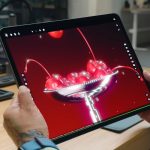
When Samsung released the Z Fold 2 last year, it delivered on its initial promise: A folding phone that works. Gone were the issues that plagued the first model — namely, breaking or peeling screens. This year’s Z Fold 3, then, didn’t really have all that much to prove. And that’s not necessarily a bad thing.
For its third-generation Fold, Samsung built upon what already existed. The company made the Z Fold 3’s frame thinner and lighter, added a 120Hz refresh rate to the cover display, introduced S Pen compatibility, and enhanced app multitasking.
Its starting price of $1,800 is still steep — despite being $200 cheaper than last year’s version. But it’s not just the price that’s keeping this foldable from going mainstream, it’s also the software learning curve.
The Z Fold 3’s new Labs feature, which allows you to tweak the aspect ratios of apps to fit the displays, might not be as easy for the everyday user to grasp as Samsung thinks it is. Add S Pen support to the mix and you have even more of a recipe for consumer confusion.
While it’s clear Samsung has finally nailed the Fold’s hardware design, there’s certainly some work left to be done on the software side of things.
A polished, streamlined design

Credit: brenda stolyar / mashable
At a glance, the Z Fold 3 looks almost identical to last year’s model and that’s because, for the most part, it is. Since Samsung pretty much perfected the design last year on the Z Fold 2, the company had the ability to focus on refinements this time around.
The Z Fold 3 is slightly thinner than its predecessor when unfolded, measuring in at 6.4mm versus 6.9mm. It’s also 11 grams lighter than the Z Fold 2, making it easier to hold one-handed when reading an article or scrolling through social media.
When folded, however, the candy bar-like build on the Fold 3 is still chunky. I didn’t mind using it with two hands to send texts or check notifications, but it felt a bit too heavy when using it one-handed. More often than not, I’d end up unfolding it to keep my hand from feeling fatigued after a while.

Credit: brenda stolyar / mashable
Samsung managed to shave the hinge down from 16.8mm on the Z Fold 2 to 14.4mm, making it far less defined. It’s no longer the first thing you notice when looking at the phone. The hinge is still free-standing, allowing you to position it at different angles when taking selfies, making video calls, or watching videos.
On the phone’s front is a 6.7-inch AMOLED cover display (2,268 x 832) which unfolds to reveal a 7.6-inch AMOLED main screen (2,208 x 1,768) — the same as seen on the Z Fold 2. The right side of the device is home to the volume rocker and a power button (which doubles as a fingerprint sensor) just underneath it. The phone is also equipped with two speaker grilles and a USB-C port on the bottom.

Credit: Brenda stolyar / mashable
On the back, you’ll notice that Samsung has redesigned the camera setup. The boxy module seen on the Z Fold 2 has been replaced here by a pill-shaped design that’s reminiscent of OnePlus’ smartphones.
This new shape gives the phone a smaller camera bump, which makes it less annoying to use unfolded on a table. It won’t rock back and forth as much when you’re tapping through apps.
Although, the Z Fold 2 didn’t suffer from the same durability issues as the first-generation model, Samsung isn’t taking any chances with the Z Fold 3. The outside of the phone is made of “Armor Aluminum,” which the company claims is the “strongest aluminum ever used on a Galaxy smartphone,” and Corning’s Gorilla Glass Victus (its strongest glass).

Credit: brenda stolyar / mashable
To add to its durability, the Z Fold 3 also has an IPX8 rating, meaning it can be submerged in up to 1.5 meters of water for about 30 minutes. It’s not dust resistant, however, so you’ll still need to be slightly careful with it. Regardless, it’s a lot less fragile than the Z Folds that have come before it.
S Pen-ready displays
Even though Samsung left the display sizes unchanged for its third-generation Fold, both screens come with new features.

Credit: brenda stolyar / mashable
Rather than designating the new super-smooth 120Hz refresh rate (an increase from 60Hz on the Fold 2) to just the main screen, Samsung has made it available on the Z Fold 3’s cover display as well. It’s adaptive though, so the refresh rate will automatically increase to 120Hz for things like mobile games and decrease to as little as 10Hz for static web pages and emails.
You can turn this adaptive refresh rate off via Settings, if you’d like or set it to “Standard.” That latter option keeps the refresh rate at 60Hz, which should help to extend battery life.

Credit: brenda stolyar / mashable
The main screen also features a 4-megapixel Under-Display Camera (UDC) which is meant to provide a more immersive viewing experience. Unlike the hole-punch selfie camera on the Z Fold 2, the UDC is supposed to be less distracting while watching videos, scrolling through photos, or gaming.
Kudos to Samsung for attempting to innovate, but it doesn’t make much of a difference. When you’re using certain apps with light backgrounds, like Twitter or Slack, you can see the outline of the UDC along with a quilted pattern over it.

Credit: brenda stolyar / mashable
I didn’t notice it after a while, but it took some getting used to. Samsung suggests using dark mode on the Z Fold 3, which definitely accentuates its appearance less. But even with a dark background, the UDC just looks like a regular sensor. Hopefully Samsung continues to improve on it with future iterations of the Fold.
As with the Z Fold 2 and original Z Fold, the crease in the middle of the main display is still visible. Thankfully, it’s really easy to get used to and after a while, you won’t really notice it.
The Z Fold 3 also has S Pen compatibility should you need it. Samsung sent me the $50 Fold Edition S Pen to test out with the phone but keep in mind that stylus is sold separately. There’s no dedicated storage slot for it, either.
If, for some reason, you’re worried about the screen breaking from the pressure of an S Pen, Samsung made sure to account for that. In addition to Ultra Thin Glass (UTG) on the main display, the company also added a layer of stretchable Polyethylene Terephthalate (PET) as protective film, which is basically a lightweight plastic. The S Pen’s retractable tip should also help to take pressure off the screen.

Credit: brenda stolyar / mashable
I did enjoy using the S Pen for to-do lists since taking notes feels similar to the experience of using a small notebook. But the Z Fold 3’s lack of an S Pen storage slot makes the accessory annoying to travel with — I’d always forget to take it with me.
You can purchase a folio case with a slot for the S Pen, but that’ll run you an additional $80. Add in the cost of the S Pen and that brings your total to $130 on top of what you’re already paying for the phone. So you might want to think hard about whether you actually need it as an accessory.
A more Fold-like software experience
The Z Fold 3 is powered by Qualcomm’s Snapdragon 888 chipset, which supports 5G connectivity (both sub-6 and mmWave), and comes in two storage configurations:
-
12GB RAM/128GB ($1,800)
-
12GB RAM/256GB ($1,900)

Credit: brenda stolyar / mashable
Its 4,400mAh dual battery is a bit smaller than the 4,500mAh used in the Z Fold 2, but it doesn’t make all that much of a difference. I still experienced a full day of battery life with standard usage which included answering emails and slack messages, as well as texting, and scrolling through social media.
I did notice, however, that when I would use it more frequently throughout the day to take photos, the battery life drained a lot faster.
I should point out that I didn’t use the Z Fold 3 to app multitask all that much. At most, I dedicated two apps for use on the main display. That said, those of you who do need a smartphone that doubles as a productivity machine can rely on the Z Fold 3 to power through three apps at once. Though, I’d suggest keeping a charger nearby just in case.


A new Labs feature will allow you to customize the size of each app window onscreen. That way, you’ll still have access to all of the app’s controls even when using it in split-screen mode. You can also adjust the aspect ratio for apps in fullscreen mode.
Samsung hasn’t made Labs easily discoverable, though. To access it, you’ll have to navigate to Settings > Advanced Features > Labs > Customize app aspect ratios. It’s a lot of steps but it’s worth it … sorta.
For example, with the Z Fold 2, Instagram would automatically open up to a 16:9 aspect ratio on the main screen. But with the Z Fold 3’s Labs feature, setting the app to “Full Screen” mode removes the black bars on the sides, creating a better viewing experience with images that fill the screen.
It’s not perfect — Instagram Stories are sometimes cropped when scrolling through, including photos and text. The same thing happens with TikTok’s closed captions. But you can always switch to the cover display for a more comfortable viewing experience.
Regardless of Labs’ inconsistencies, the feature is a step in the right direction for the Z Fold 3. It’s nice to have the option to alter unoptimized apps in an effort to get the most out of such an expensive phone. I just wish Samsung hadn’t made the feature so difficult to find.
The same old capable cameras

Credit: brenda stolyar / mashable
Samsung didn’t make any tweaks to the Z Fold 3’s rear cameras and that’s fine. The Fold lineup isn’t for those looking to replace their DSLR with a smartphone, anyway. Besides, it’s still perfectly capable of producing some really nice photos.
As far as rear sensors go, the Z Fold 3 consists of:
-
12-megapixel ultra-wide lens with f/1.8 aperture
-
12-megapixel wide-angle lens with f/2.2 aperture and a 123-degree field of view
-
12-megapixel telephoto lens (with up to 10x digital zoom)
On the front is a 10-megapixel selfie camera while the main screen has a 4-megapixel UDC.
Below are sample images from the rear cameras:

Credit: brenda stolyar / mashable
In standard mode, photos look super crisp and (as we typically see with Samsung phones) also a bit saturated.


You can see in the images above that it mainly saturates the bright colors (i.e., the reds, yellows, and pinks) within the images, making them pop in a way that’s easy on the eye without looking overedited.

Credit: brenda stolyar / mashable
Portrait Mode does well with recognizing and sharpening a subject while blurring out the background.

Credit: brenda stolyar / mashable
The ultra-wide camera does a really good job, too. While the edges of most photos I took did have slight distortion on the edges, it’s tough to notice unless you zoom in on the image.


Night mode also works well in low-light settings. On the left is a photo I took while at a bar (where the lighting was dim) on standard mode. As expected, it looks a bit fuzzy and the darker colors sort of blend together. On the right, with Night Mode enabled, the image looks far more enhanced and the colors appear more true to life.
Now, let’s move on to that 4-megapixel UDC. You’ve may have seen stories calling it out for how bad the resultant photo quality is. And it’s true, the UDC isn’t all that great at taking photos — as you can see in the photo below.

Credit: brenda stolyar / mashable
Compared to the photos below — which were taken with the cover display camera and rear cameras, respectively — the above UDC shot looks like it came from my laptop’s 720p webcam. It’s grainy, washed out, and budget-phone quality.


But that’s because it’s not meant for taking selfies. Samsung found the camera on the main screen was mostly used for video calls and rarely used for selfies. So, it makes sense as to why the company was willing to sacrifice image quality.
And as for those video calls, well, the quality is perfectly fine. I used Google Duo on the Z Fold 3 to video chat with some friends and didn’t run into any issues. Unlike the above photo sample, I actually appeared nice and clear.
Another Z Fold for the tech enthusiasts

Credit: brenda stolyar / mashable
In case you couldn’t already tell, my issues with Samsung’s Z Fold 3 are minimal: It’s still just a little too heavy. It’s still just a little too expensive. And, as the Labs feature proves, app optimization still needs some work.
Sure, the thought of never having to carry a laptop, tablet, and phone around while commuting feels liberating, but the Z Fold 3’s high price keeps it just out of the mainstream’s reach.
It’s still very much a foldable for tech enthusiasts who enjoy digging deep into a smartphone’s settings and uncovering all of its capabilities. But if Samsung wants the rest of us to drop close to $2,000 on a smartphone, it should just work without the need to tinker with hidden features and settings.
Perhaps the Z Fold 3 is proof that we don’t need a new foldable every year. Maybe, Samsung, this one could’ve waited for 2022.
Powered by WPeMatico






